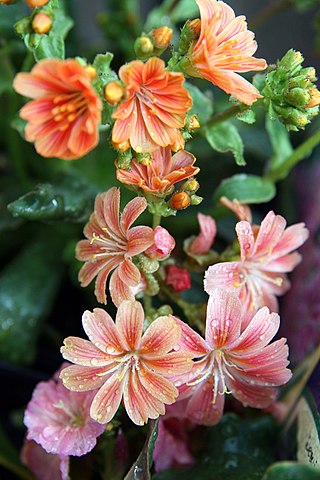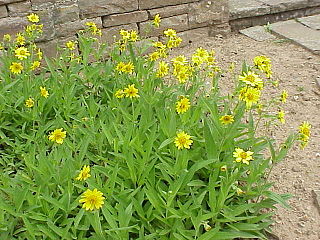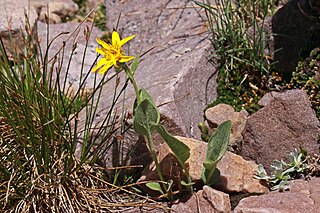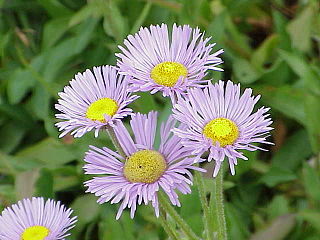
Arnica is a genus of perennial, herbaceous plants in the sunflower family (Asteraceae). The genus name Arnica may be derived from the Greek arni, "lamb", in reference to the plants' soft, hairy leaves. Arnica is also known by the names mountain tobacco and confusingly, leopard's bane and wolfsbane—two names that it shares with the entirely unrelated genus Aconitum.

Chrysothamnus, known as rabbitbrush, rabbitbush, and chamisa, are a genus of shrubs in the family Asteraceae. The native distribution is in the arid western United States, Canada, and northern Mexico. It is known for its bright white or yellow flowers in late summer.

Lewisia is a plant genus, named for the American explorer Meriwether Lewis (1774-1809) who encountered the species in 1806. The native habitat of Lewisia species is rocky ground and cliffs in western North America. Local Native Americans ate the roots, which have also been used to treat sore throats.

Chaenactis is a genus of plants in the family Asteraceae which are known generally as pincushions and dustymaidens.

Arnica longifolia is a North American species of arnica in the sunflower family, known by the common names seep-spring arnica, longleaf arnica and spearleaf arnica. This flowering perennial is native to the forests of western Canada and the western United States.

Balsamorhiza is a genus of plants in the family Asteraceae known commonly as balsamroots. These are perennials with fleshy taproots and caudices bearing erect stems and large, basal leaves. Atop the tall stems are showy yellow sunflower-like blooms. Balsamroots are native to western North America.

Hymenopappus filifolius is a North American species of flowering plant in the daisy family known by the common names fineleaf hymenopappus and Columbia cutleaf. It is native to western and central North America from Alberta and Saskatchewan south as far as Chihuahua and Baja California.

Cirsium scariosum is a species of thistle known by the common names meadow thistle, elk thistle and dwarf thistle. It is native to much of western North America from Alberta and British Columbia, south to Baja California. There are also isolated populations on the Canadian Atlantic Coast, on the Mingan Archipelago in Québec, where it is called the Mingan thistle.

Crepis modocensis is a species of flowering plant in the family Asteraceae known by the common name Modoc hawksbeard.

Crepis occidentalis is a North American species of flowering plant in the family Asteraceae known by the common names western hawksbeard, or largeflower hawksbeard. It is native to western Canada and the western United States.

Crepis runcinata is a North American species of flowering plant in the family Asteraceae known by the common name fiddleleaf hawksbeard. It is native to western and central Canada, the western and central United States and northern Mexico (Chihuahua).

Erigeron pumilus, the shaggy fleabane, or vernal daisy, is a hairy North American species of perennial plants in the family Asteraceae. It is widespread across much of western Canada and the western United States, from British Columbia east to Saskatchewan and south as far as Oklahoma and the San Bernardino Mountains of California. There have been reports of the plant growing in Yukon Territory, but these were based on misidentified specimens.

Brickellia oblongifolia, the Mojave brickellbush, is North American species of plants in the family Asteraceae. It is widespread across arid and semi-arid regions in the western United States and Canada, from British Columbia south to southern California, Arizona, and New Mexico.
Arnica gracilis is a North American species of flowering plant in the family Asteraceae, known by the common name smallhead arnica. It is native to western Canada and the northwestern United States (Washington, Oregon, Idaho, Montana, Wyoming, north-central Colorado, and northern Utah.

Arnica ovata is a North American species of flowering plant in the family Asteraceae, known by the common name sticky leaf arnica. It is native to western Canada, and the western United States.

Arnica rydbergii is a North American species of flowering plant in the family Asteraceae, known by the common name Rydberg's arnica or subalpine arnica or subalpine leopardbane. It is native to western Canada, and the western United States.

Askellia pygmaea, the dwarf alpine hawksbeard, is a species of Asian and North American plants in the tribe Cichorieae within the family Asteraceae.
Crepis atribarba is a North American species of flowering plant in the family Asteraceae known by the common names slender hawksbeard and dark hawksbeard. It is native to western Canada and the western United States It has been found in British Columbia, Utah, Washington, Oregon, Nevada, Idaho, Alberta, Montana, Wyoming, Colorado, Saskatchewan, and Nebraska.

Erigeron glabellus is a North American species of flowering plants in the family Asteraceae, called the streamside fleabane.
Eucephalus elegans is a North American species of flowering plants in the family Asteraceae known by the common name elegant aster. It is native to the western United States, largely the Great Basin, in the states of Colorado, Idaho, Montana, Nevada, Oregon, Utah, Wyoming.

















